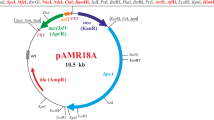Abstract
In this work we establish the chromosomal composition of a wild-type, one astaxanthin and two β-carotene overproducer strains of the red yeast Phaffia rhodozyma. The method used has been pulsed field gel electrophoresis, which has determined 9 DNA chromosomal bands in the yeast genome. The two largest bands are triplets and two other bands, VI and VIII, seem to be doublets. The size of the chromosomal bands varies between 0.35 and 2.5 Mb, suggesting a genome size of 25 Mb. The technique used, complemented with hybridization assays using specific DNA probes, provides direct information about the genomic organization of P. rhodozyma. We have also cloned and located in chromosomal bands different DNA sequences that code for the translation elongation factor 1 alpha (ef-1α), a 7.6 kb BamHI fragment of repetitive DNA (possibly rDNA) and a randomly chosen fragment (named locus R2). Additionally, we have detected a chromosomal length polymorphism between wild-type strains and mutant strains affecting carotenogenesis obtained in our laboratory.
Similar content being viewed by others
References
Andrewes AG, Phaff HJ & Starr MP (1976) Carotenoids of Phaffia rhodozyma, a red pigmented fermenting yeast. Phytochemistry 15: 1003–1007
Adrio JL, López M & Casqueiro J (1995) Electrophoretic karyotype of the astaxanthin-producing yeast Phaffia rhodozyma. Curr. Genet. 27: 447–450
An G, Schuman D & Johnson E (1989) Isolation of Phaffia rhodozyma mutants with increased astaxanthin content. Appl. Environ. Microbiol. 55: 116–124
An G & Johnson EA (1990) Influence of light on growth and pigmentation of the yeast Phaffia rhodozyma. Antonie van Leeuwenhoek 57: 191–203
An G, Bielich J, Auerbach R & Johnson E (1991) Isolation and characterization of carotenoid hyperproducing mutant of yeast by flow cytometry and cell sorting. Bio/Technology 9: 70–73
Brody H & Carbon J (1989) Electrophoretic karyotype of Aspergillus nidulans. Proc. Natl. Acad. Sci. 86: 6260–6263
Burke DT, Carle GF & Olson MV (1987) Cloning of large segments of exogenous DNA into yeast by means of artificial chromosome vectors. Science 236: 806–812
Carle G & Olson MV (1984) Separation of chromosomal DNA molecules from yeast by orthogonal-field-alternation gel electrophoresis. Nucleic Acids Res 12: 5647–5664
____ (1985) An electrophoretic karyotype for yeast. Proc. Natl. Acad. Sci. 82: 3756–3760
Carle GF, Frank M & Olson MV (1986) Electrophoretic separation of large DNA molecule by periodic inversion of the electric field. Science 232: 65–68
Chu G, Vollrath D & Davis R (1986) Separation of large molecules by contour-clamped homogeneous electric field. Science 234: 1582–1585
Chun SB, Chin JE, Bai S & An GH (1992) Strain improvement of Phaffia rhodozyma by protoplast fusion. FEMS Microbiol. Lett. 93: 221–226
Craft NE (1992) Carotenoid reverse-phase high-performance liquid chromatography methods: reference compendium. Methods in Enzymol. 213: 185–205
Devereux J, Haeberli P & Smithies O (1992) A comprehensive set of sequence analysis programs for the VAX. Nucleic Acids Res. 12: 387–395
Golubev WI (1995) Perfect state of Rhodomyces dendrorhous (Phaffia rhodozyma). Yeast 11: 101–110
Howlett B (1989) An electrophoretic karyotype for Phytophtora megasperma. Experimental Mycology 13: 199–202
Johnson E & Lewis M (1979) Astaxanthin formation by the yeast Phaffia rhodozyma. J. Gen. Microbiol. 115: 173–183
León R, Hermosilla G, Martínez C & Cifuentes V (1995) Mutagenesis in Phaffia rhodozyma. Acta Microbiol. 5: 93–101
Miller M, Yoneyama M & Soneda M (1976) Phaffia, a new yeast genus in the Deuteromycotina (Blastomycetes). Int. J. Syst. Bacteriol. 26: 286–291
Nagy A, Garamszegi N, Vágvölgyi C & Ferency L (1994) Electrophoretic karyotype of Phaffia rhodozyma strains. FEMS Microbiol. Lett. 123: 315–318
Orbach M, Vollrath D, Davis R & Yanofsky C (1988) An electrophoretic karyotype of Neurospora crassa. Mol. Cell. Biol. 8: 1469–1473
Passoth V, Hansen M, Klinner U & Emeis C (1992) The electrophoretic banding pattern of the chromosomes of Pichia stipitis and Candida shehatae. Curr. Genet. 22: 429–431
Sambroock J, Fritsch E & Maniatis T (1989) Molecular cloning. A laboratory manual. Cold Spring Harbor Laboratory, Cold Spring Harbor, N.Y.
Schwartz D & Cantor C (1984) Separation of yeast chromosomesized DNAs by pulse field gradient gel electrophoresis. Cell 37: 67–75
Smith C, Matsumoto T, Niwa O, Klco S, Fan J, Yanagida M & Cantor C (1987) An electrophoretic karyotype for Schizosaccharomyces pombe by pulsed field gel electrophoresis. Nucleic Acids Res. 15: 4481–4489
Author information
Authors and Affiliations
Rights and permissions
About this article
Cite this article
Cifuentes, V., Hermosilla, G., Martínez, C. et al. Genetics and electrophoretic karyotyping of wild-type and astaxanthin mutant strains of Phaffia rhodozyma. Antonie Van Leeuwenhoek 72, 111–117 (1997). https://doi.org/10.1023/A:1000200119447
Issue Date:
DOI: https://doi.org/10.1023/A:1000200119447



